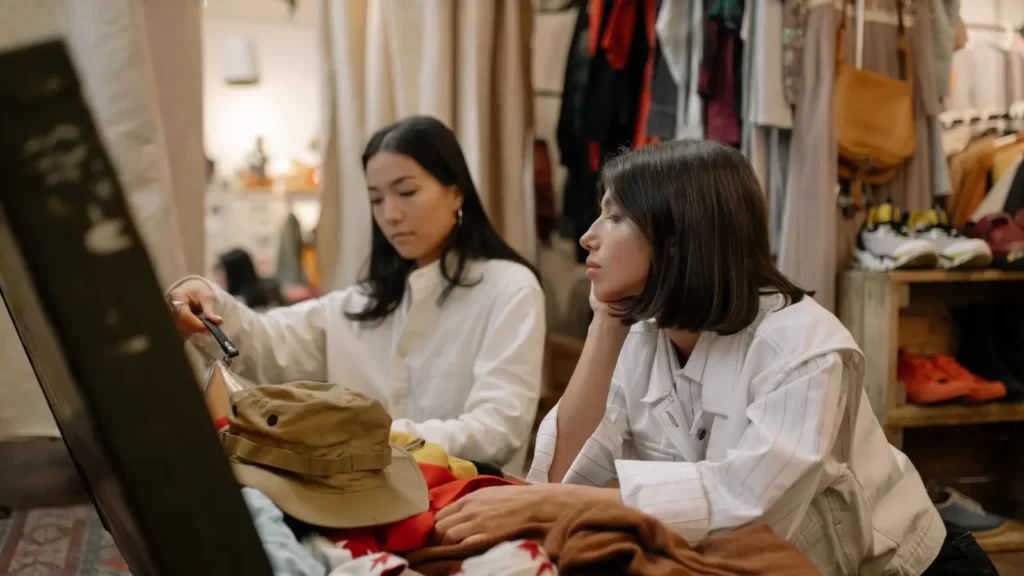Individuals contemplating how to make their wardrobe more sustainable often consider a shift towards timeless, high-quality pieces made from eco-friendly materials. There is a growing awareness of fast fashion’s environmental and ethical impacts, leading people to seek out sustainable brands and secondhand options and engage in practices like upcycling.
Many see the value in investing in a capsule wardrobe, emphasizing mindful consumption, and supporting brands prioritizing transparency and ethical production practices. While there’s an acknowledgment of the challenges related to affordability, a desire for change is evident, with an increasing number of individuals recognizing the need for education and making informed choices to contribute positively to the fashion industry’s environmental footprint.
5 Ways to make your wardrobe sustainable
Making your wardrobe more sustainable involves adopting practices that reduce environmental impact and promote ethical choices. Here are some simple and effective ways to develop your sustainable wardrobe:
Buy Less For Sustainability:
When we say, “Buy Less, Choose Well,” we suggest a mindful shopping approach. Instead of constantly purchasing new things, consider the value and quality of what you buy. Go for items that are durable and versatile, ones that will last longer and serve various purposes. This way, you contribute to reducing the demand for mass-produced goods and minimize the environmental impact of excessive consumption. Being selective in your purchases saves money and promotes a more sustainable and thoughtful lifestyle.

Shop Secondhand:
Embracing secondhand shopping is a fantastic way to extend the life cycle of clothing and other items. When you buy second hand, you’re giving a new purpose to pre-loved items, preventing them from ending up in landfills. Thrift stores, online platforms, and local markets offer a treasure trove of unique and affordable finds.
This reduces waste and lessens the need for new manufacturing, also a great source to look expensive in budget. Secondhand shopping allows you to express your style while positively impacting the environment. It’s a win-win situation where you save money and contribute to a more sustainable and circular economy.

Care for Your Clothes:
Caring for your clothes is like giving them extra love to make them last longer. Simple actions like washing clothes in cold water, air-drying instead of a dryer, and following care instructions on garment labels can make a big difference. Treating your clothes carefully reduces the frequency you need to replace them, saving money and minimizing your environmental footprint. It’s a small effort that goes a long way in promoting sustainability.

Support Sustainable Brands:
Choosing sustainable brands means endorsing companies that prioritize ethical and eco-friendly practices. These fashion brands often use environmentally friendly materials, fair labor practices, and sustainable production methods. By purchasing from them, you’re encouraging a shift toward more responsible and mindful business practices. This supports a healthier planet and sends a message to the industry that consumers value sustainability. As the demand for sustainable products increases, more companies may adopt eco-conscious practices, contributing to a positive change in the marketplace.

Educate Yourself:
Being informed about your choices environmental and social impacts is a crucial step in adopting a more sustainable lifestyle. Take the time to educate yourself about the fashion industry’s impact on the environment, the benefits of sustainable practices, and the importance of ethical consumption. Knowledge empowers you to make informed decisions about what you buy and support. Stay curious, read up on sustainable practices, and share your knowledge. The more people know, the greater the collective effort toward a more sustainable and responsible way of living.

How do you best care for summer and winter Clothes?
Caring for your clothes, whether summer or winter, ensures they last longer and look their best. Here are some general tips for caring for both types of clothing:
| Things To Do | Summer | Winter |
| Storage: | Launder or dry clean before storing to remove stains and odors. Follow care labels on clothing for washing instructions. | Launder or dry clean to remove stains and odors before storage. Pay attention to salt or de-icing residues on winter boots and jackets. |
| Cleaning: | Clean and store in a cool, dark place to prevent discoloration. Use mothballs or cedar blocks to deter pests and keep fabrics fresh. | Inspect winter coats for wear and tear, such as damaged zippers. Treat leather items with conditioner to prevent drying and cracking. |
| Maintenance: | Rotate your wardrobe to prevent overuse of specific items. Keep similar items together for easy access and inventory. | Utilize storage bins or vacuum-sealed bags to save space. Keep winter accessories (hats, gloves) together for convenience. |
| Organization: | Rotate your wardrobe to prevent overuse of specific items.Keep similar items together for easy access and inventory. | Check for damages like loose buttons or seams and repair them promptly. Avoid exposing delicate fabrics to direct sunlight for extended periods. |
10 Easy Steps to develop a sustainable Wardrobe
Just follow these steps one by one and you will see a complete change in your Wardrobe:
- Arrange Your Wardrobe
- Revise Your Shopping Patterns
- Investigate Before Making Purchases
- Compile a Roster of Preferred Sustainable Brands
- Go for Organic Textiles
- Select Timeless Garments
- Maintain Your Clothing
- Buy through Donation and Resale
- Restore Your Attire
- Borrow High-Value Items
Takeaways
Creating a sustainable wardrobe involves prioritizing quality over quantity. Choose fabrics with a lower environmental impact, such as organic cotton or recycled fibers, and consider vintage options to reduce the demand for new production. Practice mindful consumption by buying only what you truly need and love, avoiding impulsive purchases. Additionally, extend the lifespan of your garments through proper care, such as washing in cold water, air drying, and following care instructions. By embracing these principles, you contribute to a more eco-friendly and ethical approach to fashion.




